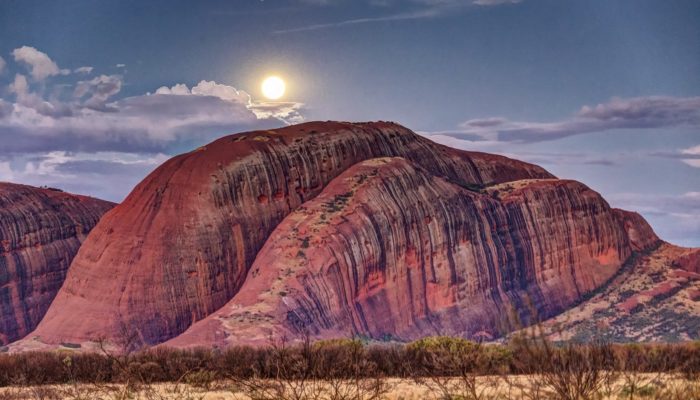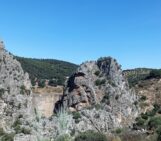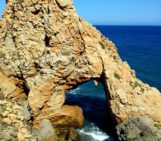
This is a high-dynamic-range (HDR) photograph of moonrise over the hills of Kata Tjuta in central Australia. The HDR technique allows details to be seen in the deep shadows and well as in the brighter parts of the image. Kata Tjuta (formerly known as The Olgas) means ‘many heads’ in the Pitjantjatjara language, spoken by the local Anangu people. The location is approximately 360 km SW of the town of Alice Springs, in the Northern Territory of Australia. The climate at this time of year (‘summer’) is blisteringly hot and mainly dry, punctuated by periodic thunderstorms and rain showers that sweep across the parched land.
The rocks are elongated dome-like outcrops of dark red-coloured, sandy, polymictic conglomerates that belong to the terrestrial Mount Currie Conglomerate, which was deposited in the Amadeus Basin, as an ancient alluvial fan, somewhere between 590 and 500 million years ago. The red colour is caused by the presence of the iron-oxide mineral hematite in the rocks. The low-angle dip of the bedding (sedimentary layering) here is crossed by dark streaks of lichen and staining due to the occasional draining of rain water off the tops of the bare red hills. Wind erosion has produced small hollows in the sides of the hills too, and these cavities tend to line up along softer beds in the sequence, and elsewhere actually form caves. Astronomically, the photograph shows what some call a ‘perfect full moon’, in which the Sun sets and the full moon rises synchronously, directly opposite on the opposing horizon.
Description by John D Clemens.
Imaggeo is the EGU’s online open access geosciences image repository. All geoscientists (and others) can submit their photographs and videos to this repository and, since it is open access, these images can be used for free by scientists for their presentations or publications, by educators and the general public, and some images can even be used freely for commercial purposes. Photographers also retain full rights of use, as Imaggeo images are licensed and distributed by the EGU under a Creative Commons licence. Submit your photos at http://imaggeo.egu.eu/upload/.




